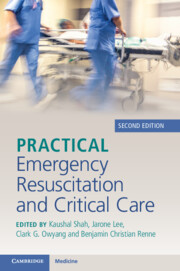Book contents
- Practical Emergency Resuscitation and Critical Care
- Practical Emergency Resuscitation and Critical Care
- Copyright page
- Contents
- Contributors
- Preface
- Section 1 General Critical Care
- Section 2 Infectious Disease Emergencies
- Section 3 Neurological Emergencies
- Section 4 Cardiovascular Emergencies
- Section 5 Respiratory Emergencies
- Section 6 Gastrointestinal Emergencies
- Section 7 Renal Emergencies
- Section 8 Hematology–Oncology Emergencies
- Section 9 Endocrine Emergencies
- Section 10 Environmental Emergencies
- Section 11 Trauma
- 47 General Trauma Principles
- 48 Severe Traumatic Brain Injury
- 49 Neck Trauma
- 50 Thoracic Trauma
- 51 Solid Organ Abdominal Trauma
- 52 Severe Pelvic Trauma
- 53 Soft Tissue Injury
- 54 Burn Resuscitation
- Section 12 End of Life
- Index
- References
54 - Burn Resuscitation
from Section 11 - Trauma
Published online by Cambridge University Press: 02 November 2023
- Practical Emergency Resuscitation and Critical Care
- Practical Emergency Resuscitation and Critical Care
- Copyright page
- Contents
- Contributors
- Preface
- Section 1 General Critical Care
- Section 2 Infectious Disease Emergencies
- Section 3 Neurological Emergencies
- Section 4 Cardiovascular Emergencies
- Section 5 Respiratory Emergencies
- Section 6 Gastrointestinal Emergencies
- Section 7 Renal Emergencies
- Section 8 Hematology–Oncology Emergencies
- Section 9 Endocrine Emergencies
- Section 10 Environmental Emergencies
- Section 11 Trauma
- 47 General Trauma Principles
- 48 Severe Traumatic Brain Injury
- 49 Neck Trauma
- 50 Thoracic Trauma
- 51 Solid Organ Abdominal Trauma
- 52 Severe Pelvic Trauma
- 53 Soft Tissue Injury
- 54 Burn Resuscitation
- Section 12 End of Life
- Index
- References
Summary
Two-thirds of reported burn cases admitted to burn centers affect less than 10% of total body surface area (TBSA) and require a relatively short hospitalization. The majority of patients with major burn injury or significant physiological derangements survive. Improvement in mortality rates is related to advances in resuscitation, infection control, modulation of the hypermetabolic response to traumatic injury and early excision and grafting. Traditional classification of burns of first, second, third and fourth degree have been replaced by a more descriptive explanation of injury depth:
- Type
- Chapter
- Information
- Practical Emergency Resuscitation and Critical Care , pp. 578 - 588Publisher: Cambridge University PressPrint publication year: 2023

